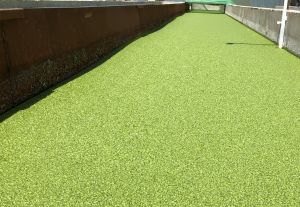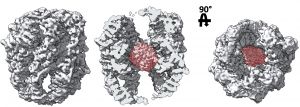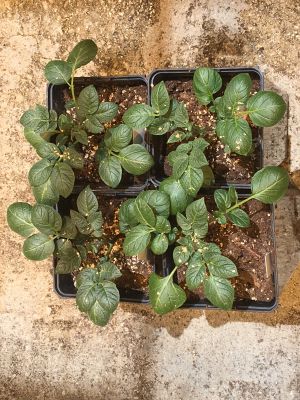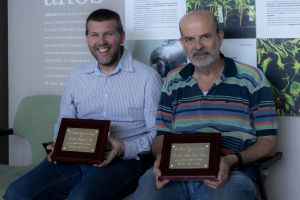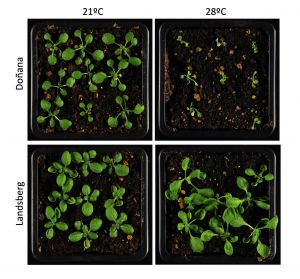- El proyecto LIFE LEMNA presenta el primer prototipo semiindustrial de Europa basado en la tecnología de cultivo de lenteja de agua (Lemna) para la recuperación de nutrientes contenidos en los purines excedentarios de porcino.
- La instalación, de 250 m2, puede producir más de 17t de biomasa/ha·año, con una productividad de proteína de origen vegetal 6-7 veces mayor que la obtenida en el cultivo de soja
- La lenteja de agua es una pequeña planta acuática menor de un cm, flotante, de forma circular y de color verde hierba intenso, que es capaz de absorber los nutrientes contenidos en los residuos ganaderos de forma muy eficiente y transformarlos en una biomasa rica en proteínas.
El proyecto europeo LIFE LEMNA busca soluciones que reduzcan el impacto medioambiental generado por la acumulación de nutrientes en los purines excedentarios de la ganadería intensiva. Encontrar soluciones ambiental y económicamente viables para estos materiales es una prioridad en España y el resto de la UE debido a la problemática de contaminación por nitratos y emisiones de CO2 asociada. Además, reducir la huella ambiental de los productos cárnicos va a resultar un factor de competitividad en el futuro por lo que el sector necesita encontrar soluciones.
Para ayudar a resolver este problema, el centro tecnológico AINIA, junto con el Centro Nacional de Biotecnología (CNB) perteneciente al Consejo Superior de Investigaciones Científicas (CSIC) y las empresa Porgaporcs y ECOBIOGAS, han desarrollado la primera planta piloto a escala semi industrial de Europa que permite recuperar los nutrientes (nitrógeno, fósforo) de los purines, y reutilizarlos en la propia zona en la que se generan.
Plant, Cell & Environment 08 July 2019
J Ochoa de Eribe, A Valli, M Martín‐Trillo, C Simón‐Mateo, JA García, B Rodamilans.
Abstract
Plants use RNA silencing as a strong defensive barrier against virus challenges, and viruses counteract this defence by using RNA silencing suppressors (RSSs). With the objective of identifying host factors helping either the plant or the virus in this interaction, we have performed a yeast two hybrid screen using P1b, the RSS protein of the ipomovirus Cucumber vein yellowing virus (CVYV, family Potyviridae), as a bait. The C‐8 sterol isomerase HYDRA1 (HYD1), an enzyme involved in isoprenoid biosynthesis and cell membrane biology, and required for RNA silencing, was isolated in this screen. The interaction between CVYV P1b and HYD1 was confirmed in planta by Bimolecular Fluorescence Complementation assays. We demonstrated that HYD1 enhances RNA silencing activity in the presence of CVYV P1b in an agroinfiltration assay. Moreover, expression of HYD1 inhibited the infection of the potyvirus Plum pox virus, especially when antiviral RNA silencing was boosted by high temperature or by co‐expression of homologous sequences. Our results reinforce previous evidence highlighting the relevance of particular composition and structure of cellular membranes for RNA silencing and viral infection. We report a new interaction of an RSS protein from the Potyviridae family with a member of the isoprenoid biosynthetic pathway.
Viruses undergo mesoscopic morphological changes as they interact with host interfaces and in response to chemical cues. The dynamics of these changes, over the entire temporal range relevant to virus processes, are unclear. Here, we report on creep compliance experiments on a small icosahedral virus under uniaxial constant stress. We find that even at small stresses, well below the yielding point and generally thought to induce a Hookean response, strain continues to develop in time via sparse, randomly distributed, relatively rapid plastic events. The intermittent character of mechanical compliance only appears above a loading threshold, similar to situations encountered in granular flows and the plastic deformation of crystalline solids. The threshold load is much smaller for the empty capsids of the brome mosaic virus than for the wild-type virions. The difference highlights the involvement of RNA in stabilizing the assembly interface. Numerical simulations of spherical crystal deformation suggest intermittency is mediated by lattice defect dynamics and identify the type of compression-induced defect that nucleates the transition to plasticity.
doi: 10.1021/acsnano.9b02133.
- Las chaperonas moleculares son clave para el equilibrio entre la síntesis y degradación de las proteínas celulares
- Para analizar la función de estos complejos y conocer su estructura, los científicos han empleado el criomicroscopio electrónico del Centro Nacional de Biotecnología del CSIC
Un trabajo codirigido por investigadores del Centro Nacional de Biotecnología del Consejo Superior de Investigaciones Científicas (CSIC) ha determinado el mecanismo de funcionamiento del complejo CCT, una de las chaperonas moleculares más importantes en organismos eucariotas. Los científicos, que publican sus resultados en el último número de la revista Nature Communications, han empleado un criomicroscopio electrónico de última generación.
Nature Communications 10, Article number: 2865 (2019)
Jorge Cuéllar, W. Grant Ludlam, Nicole C. Tensmeyer, Takuma Aoba, Madhura Dhavale, César Santiago, M. Teresa Bueno-Carrasco, Michael J. Mann, Rebecca L. Plimpton, Aman Makaju, Sarah Franklin, Barry M. Willardson & José M. Valpuesta.
Abstract
The mechanistic target of rapamycin (mTOR) kinase forms two multi-protein signaling complexes, mTORC1 and mTORC2, which are master regulators of cell growth, metabolism, survival and autophagy. Two of the subunits of these complexes are mLST8 and Raptor, β-propeller proteins that stabilize the mTOR kinase and recruit substrates, respectively. Here we report that the eukaryotic chaperonin CCT plays a key role in mTORC assembly and signaling by folding both mLST8 and Raptor. A high resolution (4.0 Å) cryo-EM structure of the human mLST8-CCT intermediate isolated directly from cells shows mLST8 in a near-native state bound to CCT deep within the folding chamber between the two CCT rings, and interacting mainly with the disordered N- and C-termini of specific CCT subunits of both rings. These findings describe a unique function of CCT in mTORC assembly and a distinct binding site in CCT for mLST8, far from those found for similar β-propeller proteins.
Investigadores del CSIC colaboran en un estudio internacional sobre el origen y la evolución de las variedades europeas de la patata, con la ayuda de las colecciones históricas de los herbarios. La adaptación fuera de su región de origen puede haber seguido rutas similares en Europa y el Sur de América.
Plant Cell. 2019 Jun;31(6):1222-1237.
Méndez-Vigo B, Ausín I, Zhu W2, Mollá-Morales A, Balasubramanian S, Alonso-Blanco C.
Abstract
Understanding how plants adapt to ambient temperatures has become a major challenge prompted by global climate change. This has led to the identification of several genes regulating the thermal plasticity of plant growth and flowering time. However, the mechanisms accounting for the natural variation and evolution of such developmental plasticity remain mostly unknown. In this study, we determined that natural variation at ICARUS2 (ICA2), which interacts genetically with its homolog ICA1, alters growth and flowering time plasticity in relation to temperature in Arabidopsis (Arabidopsis thaliana). Transgenic analyses demonstrated multiple functional effects for ICA2 and supported the notion that structural polymorphisms in ICA2 likely underlie its natural variation. Two major ICA2 haplogroups carrying distinct functionally active alleles showed high frequency, strong geographic structure, and significant associations with climatic variables related to annual and daily fluctuations in temperature. Genome analyses across the plant phylogeny indicated that the prevalent plant ICA genes encoding two tRNAHis guanylyl transferase 1 units evolved ∼120 million years ago during the early divergence of mono- and dicotyledonous clades. In addition, ICA1/ICA2 duplication occurred specifically in the Camelineae tribe (Brassicaceae). Thus, ICA2 appears to be ubiquitous across plant evolution and likely contributes to climate adaptation through modifications of thermal developmental plasticity in Arabidopsis.
doi: 10.1105/tpc.18.00938. Epub 2019 Apr 16
- Identificados en ‘Arabidopsis thaliana’ los genes que regulan un nuevo mecanismo de adaptación a altas temperaturas
- La interacción genética entre dos genes duplicados regula el ciclo de la división celular, según un estudio del CSIC
Las plantas están sometidas a fluctuaciones de temperatura diarias y estacionales que provocan cambios en sus patrones de expresión genética. Esta plasticidad les permite adaptarse a las condiciones ambientales mediante cambios en su ritmo de crecimiento y tiempo de floración.
Entender cómo las plantas de diferentes regiones del mundo se adaptan a las temperaturas del ambiente en el que crecen es el objetivo de las investigaciones de un equipo de científicos del Consejo Superior de Investigaciones Científicas (CSIC) en el Centro Nacional de Biotecnología. En su último trabajo, publicado en la revista The Plant Cell, los investigadores han identificado en la planta modelo Arabidopsis thaliana dos genes duplicados, ICARUS1 y 2 (ICA1 e ICA2), que están implicados en la regulación de la respuesta térmica del desarrollo de las plantas.
J Immunother Cancer. 2019 Jun 13;7(1):151.
Ogando J, Sáez ME, Santos J, Nuevo-Tapioles C, Gut M, Esteve-Codina A, Heath S, González-Pérez A, Cuezva JM, Lacalle RA, Mañes S
Abstract
BACKGROUND: Binding of the programmed death-1 (PD-1) receptor to its ligands (PD-L1/2) transduces inhibitory signals that promote exhaustion of activated T cells. Blockade of the PD-1 pathway is widely used for cancer treatment, yet the inhibitory signals transduced by PD-1 in T cells remain elusive.
METHODS: Expression profiles of human CD8+ T cells in resting, activated (CD3 + CD28) and PD-1-stimulated cells (CD3 + CD28 + PD-L1-Fc) conditions were evaluated by RNA-seq. Bioinformatic analyses were used to identify signaling pathways differentially regulated in PD-1-stimulated cells. Metabolic analyses were performed with SeaHorse technology, and mitochondrial ultrastructure was determined by transmission electron microscopy. PD-1-regulated mitochondrial genes were silenced using short-hairpin RNA in primary cells. Blue native gel electrophoresis was used to determine respiratory supercomplex assembly.
RESULTS: PD-1 engagement in human CD8+ T cells triggers a specific, progressive genetic program different from that found in resting cells. Gene ontology identified metabolic processes, including glycolysis and oxidative phosphorylation (OXPHOS), as the main pathways targeted by PD-1. We observed severe functional and structural alterations in the mitochondria of PD-1-stimulated cells, including a reduction in the number and length of mitochondrial cristae. These cristae alterations were associated with reduced expression of CHCHD3 and CHCHD10, two proteins that form part of the mitochondrial contact site and cristae organizing system (MICOS). Although PD-1-stimulated cells showed severe cristae alterations, assembly of respiratory supercomplexes was unexpectedly greater in these cells than in activated T cells. CHCHD3 silencing in primary CD8+ T cells recapitulated some effects induced by PD-1 stimulation, including reduced mitochondrial polarization and interferon-γ production following T cell activation with anti-CD3 and -CD28 activating antibodies.
CONCLUSIONS: Our results suggest that mitochondria are the main targets of PD-1 inhibitory activity. PD-1 reprograms CD8+ T cell metabolism for efficient use of fatty acid oxidation; this mitochondrial phenotype might explain the long-lived phenotype of PD-1-engaged T cells.
COOKIES POLICY
A cookie is a text file that is stored on your computer or mobile device via a web server and only that server will be able to retrieve or read the contents of the cookie and allow the Web site remember browser preferences and navigate efficiently. Cookies make the interaction between the user and the website faster and easier.
General information
This Website uses cookies. Cookies are small text files generated by the web pages you visit, which contain the session data that can be useful later in the website. In this way this Web remembers information about your visit, which can facilitate your next visit and make the website more useful.
How do cookies?
Cookies can only store text, usually always anonymous and encrypted. No personal information is ever stored in a cookie, or can be associated with identified or identifiable person.
The data allow this website to keep your information between the pages, and also to discuss how to interact with the website. Cookies are safe because they can only store information that is put there by the browser, which is information the user entered in the browser or included in the page request. You can not run the code and can not be used to access your computer. If a website encrypts cookie data, only the website can read the information.
What types of cookies used?
The cookies used by this website can be distinguished by the following criteria:
1. Types of cookies as the entity that manages:
Depending on who the entity operating the computer or domain where cookies are sent and treat the data obtained, we can distinguish:
- Own cookies: are those that are sent to the user's terminal equipment from a computer or domain managed by the editor itself and from which provides the service requested by the user.
- Third party cookies: these are those that are sent to the user's terminal equipment from a machine or domain that is not managed by the publisher, but by another entity data is obtained through cookies.
In the event that the cookies are installed from a computer or domain managed by the editor itself but the information collected by these is managed by a third party can not be considered as party cookies.
2. Types of cookies as the length of time that remain active:
Depending on the length of time that remain active in the terminal equipment can be distinguished:
- Session cookies: cookies are a type designed to collect and store data while the user accesses a web page. Are usually used to store information that only worth preserving for the service requested by the user at any one time (eg a list of products purchased).
- Persistent cookies: cookies are a type of data which are stored in the terminal and can be accessed and treated for a period defined by the head of the cookie, and can range from a few minutes to several years.
3. Cookies types according to their purpose:
Depending on the purpose for which the data are processed through cookies, we can distinguish between:
- Technical cookies: these are those that allow the user to navigate through a web page or application platform and the use of different options or services it exist as, for example, control traffic and data communication, identify the session, access to restricted access parts, remember the elements of an order, make the buying process an order, make an application for registration or participation in an event, use security features while browsing store content for dissemination videos or sound or share content via social networks.
- Customization cookies: these are those that allow the user to access the service with some general characteristics based on a predefined set of criteria in the user terminal would eg language, the type of browser through which you access the service, the locale from which you access the service, etc.
- Analysis cookies: they are those that allow the responsible for them, monitoring and analyzing the behavior of users of the web sites that are linked. The information gathered through such cookies are used in measuring the activity of web sites, application or platform and for the profiling of user navigation of such sites, applications and platforms, in order to make improvements function data analysis how users use the service.
Management tool cookies
This Website uses Google Analytics.
Google Analytics is a free tool from Google that primarily allows website owners know how users interact with your website. Also, enable cookies in the domain of the site in which you are and uses a set of cookies called "__utma" and "__utmz" to collect information anonymously and reporting of website trends without identifying individual users..
For statistics of use of this website use cookies in order to know the level of recurrence of our visitors and more interesting content. This way we can concentrate our efforts on improving the most visited areas and make the user more easily find what they are looking for. On this site you can use the information from your visit for statistical evaluations and calculations anonymous data and to ensure the continuity of service or to make improvements to their websites. For more details, see the link below privacy policy [http://www.google.com/intl/en/policies/privacy/]
How to manage cookies on your computer: disabling and deleting cookies
All Internet browsers allow you to limit the behavior of a cookie or disable cookies within settings or browser settings. The steps for doing so are different for each browser, you can find instructions in the help menu of your browser.
If you decline the use of cookies, since it is possible thanks to the preferences menu of your browser or settings, reject, this website will continue to function properly without the use of the same.
Can you allow, block or delete cookies installed on your computer by setting your browser options installed on your computer:
- For more information about Internet Explorer click here.
- For more information on Chrome click here.
- For more information about Safari click here.
- For more information about Firefox click here.
Through your browser, you can also view the cookies that are on your computer, and delete them as you see fit. Cookies are text files, you can open and read the contents. The data within them is almost always encrypted with a numeric key corresponding to an Internet session so often has no meaning beyond the website who wrote it.
Informed consent
The use of this website on the other hand, implies that you paid your specific consent to the use of cookies, on the terms and conditions provided in this Cookies Policy, without prejudice to the measures of deactivation and removal of cookies that you can take, and mentioned in the previous section.

